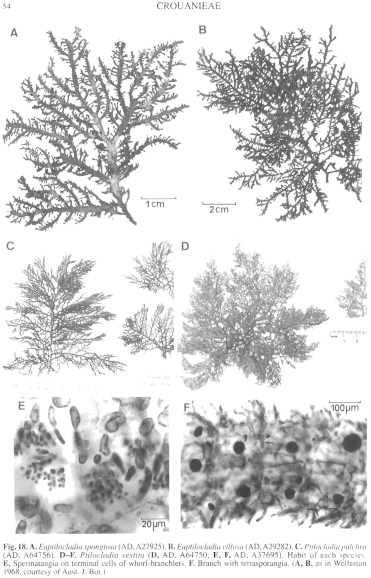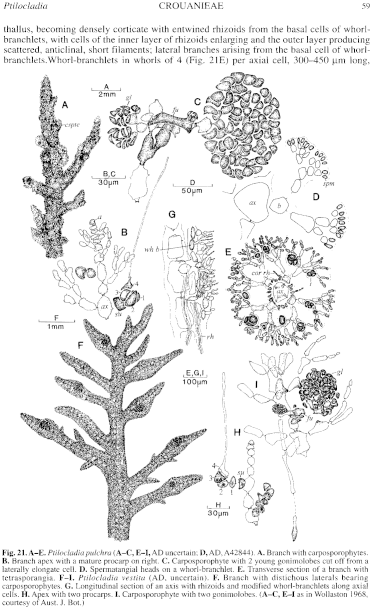|
|
|
|
|
|||||||||||
|
Electronic Flora of South Australia Species Fact Sheet
Phylum Rhodophyta – Order Ceramiales – Family Ceramiaceae – Tribe Crouanieae
Selected citations: Silva et al. 1996: 422. Wollaston 1968: 255, figs 9F–S, 10, pl. 3.
Synonyms
Wrangelia agardhiana Harvey 1855a: 545.
Crouania agardhiana (Harvey) Harvey 1863: pl. 256. J. Agardh 1876: 87. Sonder 1881:12. Wilson 1892: 185.
Muellerena agardhiana (Harvey) De Toni 1903: 1389. Lucas 1909: 50. Lucas & Perrin 1947: 345. May 1965: 370. Mazza 1911: No. 398.
Ptilocladia agardhiana (Harvey) Wollaston 1968: 261, fig. 9A–E.
Crouania insignis Harvey 1859b: 331, pl. 193B. J. Agardh 1876: 87. Bastow 1899: pl. 2 fig. 59. Sonder 1881: 12. Tate 1882: 17. Wilson 1892: 185.
Muellerena? insignis (Harvey) De Toni 1903: 1389. Guiler 1952: 97. Lucas 1909:50; 1929a: 25. Lucas & Perrin 1947: 346. Mazza 1911: No. 399. Womersley 1948: 161; 1950: 178.
Gulsoniopsis insignis (Harvey) Hommersand 1963: 167. May 1965: 370.
Thallus (Figs 18C, 21A) medium to dark red-brown, 5–15 (–30) cm high, spongiose, branches terete, alternately subdistichous to irregular, usually pyramidal in form with long axes or lateral branches and progressively shorter second and third order laterals towards their apices; branches completely covered with whorl-branchlets; axes and lower branches 1–2 mm in diameter, decreasing gradually to 0.6–1 mm in diameter near branch apices. Holdfast rhizoidal, 1–3 mm across; epilithic. Structure. Axes with short apical cells 12–15 µm in diameter and L/D 0.5–1, increasing to 350–500 µm in diameter and L/D 1–2 in lower thallus, becoming densely corticate with entwined rhizoids from the basal cells of whorl-branchlets, with cells of the inner layer of rhizoids enlarging and the outer layer producing scattered, anticlinal, short filaments; lateral branches arising from the basal cell of whorl-branchlets. Whorl-branchlets in whorls of 4 (Fig. 21E) per axial cell, 300–450 µm long, di- or trichotomous 5–7 times, basal cells 50–80 µm in diameter and L/D 1–1.5, tapering to terminal cells 10–15 µm in diameter and L/D 1–1.5, terminating in a short row of 2–3 ovoid cells, often with a hair; gland cells absent, mature axial cells often containing crystal-like inclusions. Cells uninucleate; rhodoplasts elongate, ribbon like in larger cells.
Reproduction: Gametophytes dioecious. Procarps (Fig. 21B) situated on the basal cell of shorter whorl-branchlets several cells below the apices of short determinate branches, with a supporting cell bearing a curved, 4-celled, carpogonial branch. Post-fertilization fusion with the auxiliary cell occurs via a connecting cell and the auxiliary cell divides to a lower foot cell and an upper cell which produces 2–3 successive, lateral, rounded gonimolobes (Fig. 21C) 250–450 across of carposporangia 25–40 µm across. The carposporophyte is on a short lateral branch surrounded by adjacent whorl-branchlets (Fig. 21A). Spermatangia (Fig. 21D) are cut off from terminal cells of whorl-branchlets, ovoid, 2–4 µm in diameter.
Tetrasporangia (Fig. 21E) occur on mid-cells of whorl-branchlets, sessile, subspherical to ovoid, 50–75 µm in diameter, tetrahedrally to subcruciately divided.
Type from "Nov. Holl. austro occid." (Preiss); holotype in MEL, 8445.
Selected specimens: Eyre, W. Aust., drift (Gordon, 22.xi.1968; AD, A34226). Elliston, S. Aust., pools on outer reef (Womersley, 14.i.1951; AD, A15126) and 10–11 m deep in bay (Shepherd, 20.x.1969; AD, A35007). Wanna, S. Aust., upper sublittoral pools (Womersley, 19.ii.1959; AD, A22467). Tapley Shoal, S. Aust., 13 m deep (Shepherd, 5.ii.1969; AD, A33765). Victor Harbor, S. Aust., drift (Womersley, 18.iii.1966; AD, A30031). Seal Bay, Kangaroo I., S. Aust., drift (Womersley, 29.x.1966; AD, A31054). Pennington Bay, Kangaroo I., S. Aust., sublittoral fringe (Womersley, 5.i.1947; AD, A4401). Robe, S. Aust., reef pools in bay (Womersley, 5.xii.1995; AD, A64756). Queenscliff, Vic., drift (Norris, 21.i.1963; AD, A26307, A26308). Flinders, Vic., drift (Gordon-Mills, 9.xii.1983; AD, A55446). Walkerville, Vic., at low tide level (Sinkora A2627, 22.xi.1979; AD, A61035). Rocky Cape, NW Tas., lower eulittoral pools (Womersley, 17.x.1982; AD, A55606). Currie R. mouth, Tas., upper sublittoral (Womersley, 28.i.1949; AD, A10343). Tesselated Pavements, Eaglehawk Neck, Tas., drift (Gordon, 18.i.1966; AD, A30118). Lady Bay, Southport, Tas., 2–3 m deep (Brown & Kenchington, 14.x.1986; AD, A57661).
Distribution: Near Fremantle, W. Aust., to Queenscliff, Vic., and N Tasmania.
Taxonomic notes: P. pulchra is often common in pools on rough-water coasts, extending to 13 m deep.
P. agardhiana is identical in structure with P. pulchra, differing only relatively slightly in habit, being less pyramidal. It may be a more sheltered habitat form, and intergrades occur between typical P. pulchra and P. agardhiana; the two 'species' are here combined.
References:
AGARDH, J.G. (1876). Species Genera et Ordines Algarum. Vol. 3, Part 1- Epicrisis systematic Floridearum, pp. i-vii, 1–724. (Weigel: Leipzig.)
BASTOW, R.A. (1899). Key to tribes and genera of the Florideae. J. Proc. R. Soc. N.S.W. 33, 45–47, Plates 1, 2.
DE TONI, G.B. (1903). Sylloge Algarum omnium hucusque Cognitarum. Vol. 4. Florideae. Sect. 3, pp. 775–1521 + 1523–1525. (Padua.)
GUILER, E.R. (1952). The marine algae of Tasmania. Checklist with localities. Pap. Proc. R. Soc. Tasmania 86, 71–106.
HARVEY, W.H. (1855a). Some account of the marine botany of the colony of Western Australia. Trans. R. Jr. Acad. 22, 525–566.
HARVEY, W.H. (1859b). Algae. In Hooker, J.D., The Botany of the Antarctic Voyage. III. Flora Tasmaniae. Vol. II, pp. 282–343, Plates 185–196. (Reeve: London.)
HARVEY, W.H. (1863). Phycologia Australica. Vol. 5, Plates 241–300, synop., pp. i-lxxiii. (Reeve: London.)
HOMMERSAND, M.H. (1963). The morphology and classification of some Ceramiaceae and Rhodomelaceae. Univ. Calif Pubis. Bot. 35(2), 165–366.
LUCAS, A.H.S. & PERRIN, F. (1947). The Seaweeds of South Australia. Part 2. The Red Seaweeds. (Govt Printer: Adelaide.)
LUCAS, A.H.S. (1909). Revised list of the Fucoideae and Florideae of Australia. Proc. Linn. Soc. N.S.W. 34, 9–60.
LUCAS, A.H.S. (1929a). The marine algae of Tasmania. Pap. Proc. R. Soc. Tasm. 1928, 6–27.
MAY, V. (1965). A census and key to the species of Rhodophyceae (red algae) recorded from Australia. Contr. N.S.W. natn. Herb. 3, 349–429.
MAZZA, A. (1911). Saggio di Algologia Oceanica. Nuova Notarisia 22, Nos. 369–393.
SILVA, P.C., BASSON, P.W. & MOE, R.L. (1996). Catalogue of the Benthic Marine Algae of the Indian Ocean. (University of California Press: Berkeley, Los Angeles & London.)
SONDER, O.G. (1845). Nova Algarum genera et species, quas in itinere ad oras occidentales Novae Hollandiae, collegit L. Preiss, Ph.Dr. Bot. Zeit. 3, 49–57.
SONDER, O.W. (1848). Algae. In Lehmann, C., Plantae Preissianae. Vol. 2, pp. 161–195. (Hamburg.)
SONDER, O.W. (1881). In Mueller, F., Fragmenta Phytographiae Australiae. Supplementum ad volumen undecinum: Algae Australianae hactenus cognitae, pp. 1–42, 105–107. (Melbourne.)
TATE, R. (1882). A list of the charas, mosses, liverworts, lichens, fungs, and algals of extratropical South Australia. Trans. R. Soc. S. Aust. 4, 5–24.
WILSON, J.B. (1892). Catalogue of algae collected at or near Port Phillip Heads and Western Port. Proc. R. Soc. Vict. 4, 157–190.
WOLLASTON, E.M. (1968).Morphology and taxonomy of southern Australian genera of Crouanieae Schmitz (Ceramiaceae, Rhodophyta). Aust. J. Bot. 16, 217–417.
WOMERSLEY, H.B.S. (1948). The marine algae of Kangaroo Island. II. The Pennington Bay Region. Trans. R. Soc. S. Aust. 72, 143–166, Plates 10–15.
WOMERSLEY, H.B.S. (1950). The marine algae of Kangaroo Island. III. List of Species 1. Trans. R. Soc. S. Aust. 73, 137–197.
The Marine Benthic Flora of Southern Australia Part IIIC complete list of references.
Publication:
Womersley, H.B.S. (24 December, 1998)
The Marine Benthic Flora of Southern Australia
Rhodophyta. Part IIIC. Ceramiales – Ceramiaceae, Dasyaceae
©State Herbarium of South Australia, Government of South Australia
Illustrations in Womersley Part IIIA, 1998: FIGS 18C, 21 A–E.

Figure 18 enlarge
Fig. 18. A. Euptilocladia spongiosa (AD, A27925). B. Euptilocladia villosa (AD, A29282). C. Ptilocladia pulchra (AD, A64756). D–F. Ptilocladia vestita (D, AD, A64750; E, F, AD, A37695). Habit of each species. E. Spennatangia on terminal cells of whorl-branchlets. F. Branch with tetrasporangia. (A, B, as in Wollaston 1968, courtesy of Aust. J. Bot.)

Figure 21 enlarge
Fig. 21. A–E. Ptilocladia pulchra (A–C, E–I, AD uncertain; D, AD, A42844). A. Branch with carposporophytes. B. Branch apex with a mature procarp on right. C. Carposporophyte with 2 young gonimolobes cut off from a laterally elongate cell. D. Spermatangial heads on a whorl-branchlet. E. Transverse section of a branch with tetrasporangia. F–I. Ptilocladia vestita (AD, uncertain). F. Branch with distichous laterals bearing carposporophytes. G. Longitudinal section of an axis with rhizoids and modified whorl-branchlets along axial cells. H. Apex with two procarps. I. Carposporophyte with two gonimolobes. (A–C, E–I as in Wollaston 1968, courtesy of Aust. J. Bot.)

|
Email Contact: State Herbarium of South Australia |

|